the NachtKabarett
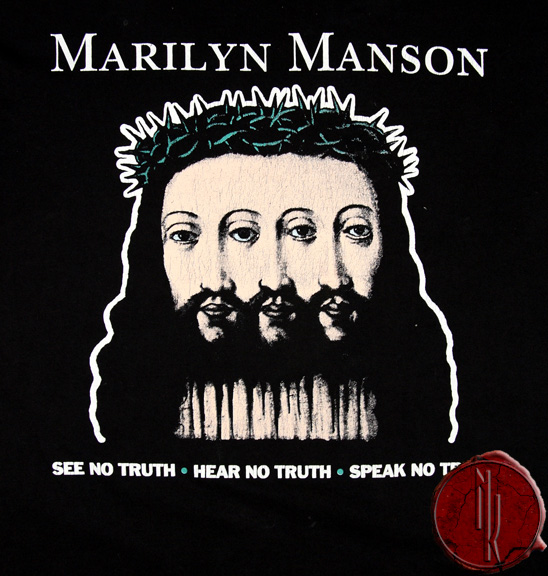 |
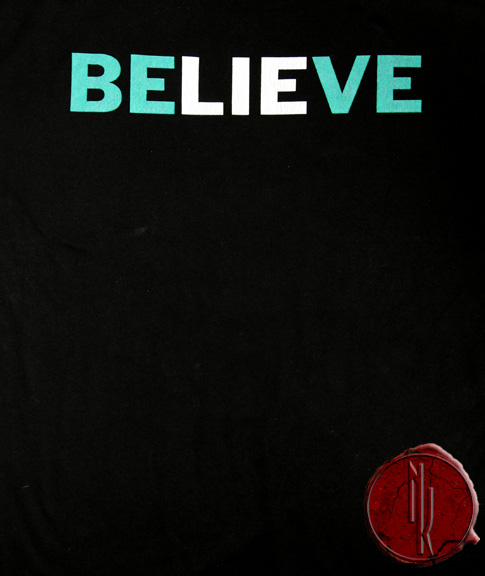 |
'Antichrist Svperstar' era t-shirt, circa 1997 depicting a novel variation of the traditional 'three wise monkeys' proclaiming "hear no evil, see no evil, speak no evil", but altered within the context of those who pervert the original teachings of Christianity and ween their followers into blindly conforming their wills. Illustrated via a three faced Christ denouncing the Truth.
BELIEVE
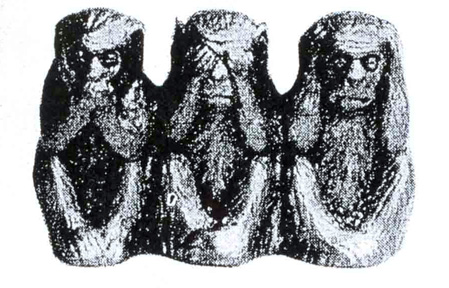 Engraving of the Three Wise Monkeys | See no evil, Hear no evil, Speak no evil
Engraving of the Three Wise Monkeys | See no evil, Hear no evil, Speak no evilThough the imagery originated as 17th Century folkloric Japanese iconography it has also been adopted by Christians throughout the world as an admonition toward living a pious and holy life. Interesting enough the imagery denotes man as his base, primordially self as an ape (while many Christians, adopting the symbolism, also adamantly decry the Theory of Evolution as mortal blasphemy!) with the illustration that man must rise above his primitive desires and emotions in order to reach the gates of Heaven in the afterlife.
Certain, more rare, variations (at least which have been witnessed in person by this author) have been seen to contain a fourth monkey with his hands upon his crotch, as an admonition towards abstinence and to deter one from sex and sexuality as to liken it as being an affront to God.
 The Three Wise Monkeys as they appear within the inlet artwork to 'Portrait of an American Family', along with representations of "Manson", "Twiggy" and "Pogo"
The Three Wise Monkeys as they appear within the inlet artwork to 'Portrait of an American Family', along with representations of "Manson", "Twiggy" and "Pogo"The three monkeys additionally are represented over three years prior within 'Portrait of an American Family', in both lyric and album artwork.
I do a crooked little dance with my funny little monkey...Organ Grinder Track 4
The rabbit's just a monkey in disguise...Dope Hat Track 6
I had a little monkey, I sent him to the country and I fed him on gingerbread. Along came a choo choo and knocked my monkey coo coo and now my monkey's deadMy Monkey Track 12
Sara Lee Interview with Marilyn Manson. Sep 24th, 1994Sara Lee: What's your biggest non-musical influence or motivation for doing your music?
Marilyn Manson: Non-musical influence? Anton LaVey: his writing.... Nietzsche.... Willy Wonka is probably my biggest non-musical influence.
Sara Lee: That partially explains the recurring themes on Portrait of an American Family of candy, innocence and sweetness, children.... What about the monkeys?
Marilyn Manson: Right, right. You noticed that.... I've kind of put up the challenge for someone to figure out what the.... I don't know.... it's some kind of weird "trinity of the monkey" on the album that I haven't even figured out. I realized after the album was already out that the monkey occurs three times -- in three different songs. And just by coincidence, that picture under the CD (inside the case) has three monkeys on it. There's something there to be discovered.... I just can't say what.
 Screen shot from the 'Disposable Teens' video in which Christ is depicted throughout as a chimp ; here seated at Christ's central position with the band as his disciples on either side as a reenactment of The Last Supper
Screen shot from the 'Disposable Teens' video in which Christ is depicted throughout as a chimp ; here seated at Christ's central position with the band as his disciples on either side as a reenactment of The Last SupperManson's exact phraseology "Trinity of the Monkey" acts as a further allusion to a complete inversion and debasement of Christian mythology, with that of the traditional 'Father', 'Son' and 'Holy Spirit' being represented as mere simians. This instance acts as one of the very first imageries which Manson has toyed in later years involving apes, chimps and monkeys to represent the concept of evolution ; both personal transformation and spiritual evolution, in addition to an affront towards Christianity which holds itself to self righteously ascended above the banality and ape-like disposition of the common man.
Nietzsche (whom Manson mentioned in the quote above), outlined within 'The Antichrist', that Christianity holds blind faith and reactionary ignorance towards science and rationalism to be a virtue rather than a detriment to itself. With predominantly Protestant Christian Americans (who, also, Manson's satire within 'Portrait Of An American Family' is largely directed towards) acting as one of the main, and most vocal, groups who actively condemn belief in the concept of Evolution as a mortal sin, the suggestion of their God as being no more than a mere primordial monkey is one of the most inflammatory derisions which can be made.
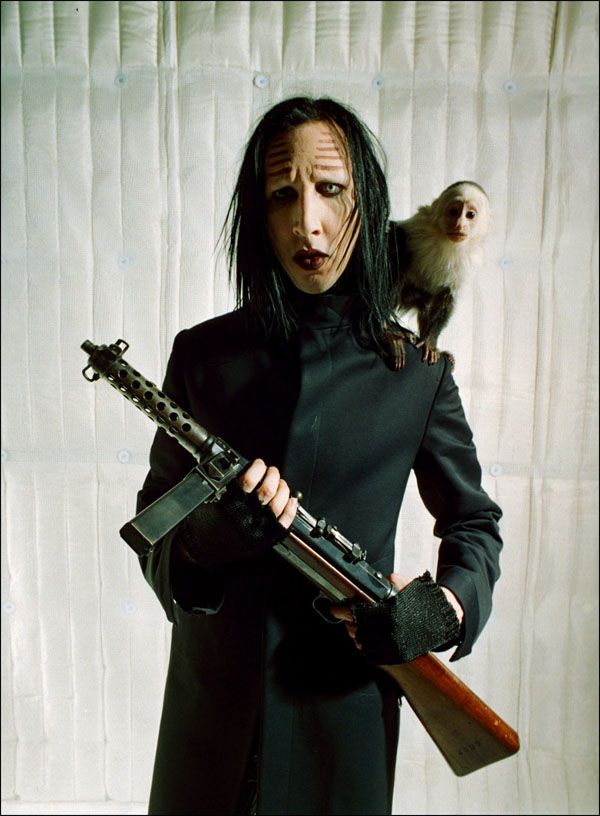 "The monkey / The Man[son] / then the gun." Manson during the 'Holy Wood' era with a monkey on his shoulder, the time period which contained Manson's most numerous and overt references towards apes and Evolution, though most predominantly as a representation of personal evolution as a transformative journey.
"The monkey / The Man[son] / then the gun." Manson during the 'Holy Wood' era with a monkey on his shoulder, the time period which contained Manson's most numerous and overt references towards apes and Evolution, though most predominantly as a representation of personal evolution as a transformative journey. Marilyn Manson. Still frame from 'The Beautiful People', 1996. "If you live with apes, man, it's hard to be clean..."
Marilyn Manson. Still frame from 'The Beautiful People', 1996. "If you live with apes, man, it's hard to be clean..."
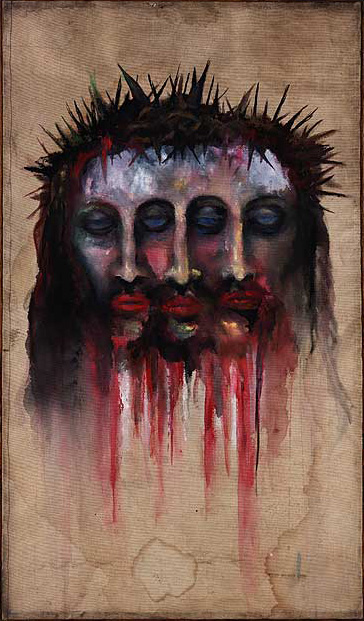 'Trismegistus' watercolor by Marilyn Manson, painted on canvas as part of a 19th century portable wooden embalming table
'Trismegistus' watercolor by Marilyn Manson, painted on canvas as part of a 19th century portable wooden embalming tableThe "See No Truth" imagery would also reappear in 2004 in the form of a watercolor painting by Manson titled 'Trismegistus', a reference to Hermes Trismegistus, or "Hermes The Thrice-Great". The Greek God Hermes and the Egyptian god Thoth merged into one figure who was said to be the first and greatest magician and the believed inventor of medieval alchemy.

S e e a l s o o n T h e N A C H T K A B A R E T T :
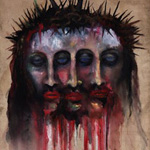  |
TRISMEGISTUS | Trismegistus is the title of Marilyn Manson's art exhibition which opened in Paris on September 14th, 2004, followed by showing in Germany and around the world. The title piece painting of Trismegistus is a three-fold watercolour of the face of Christ and is named after the great magician Hermes Trismegistus, who is credited by some as to to be the originator (at least metaphorically) of Alchemy.